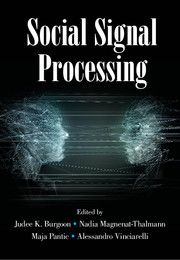Book contents
- Frontmatter
- Contents
- Contributors
- 1 Introduction: Social Signal Processing
- Part I Conceptual Models of Social Signals
- Part II Machine Analysis of Social Signals
- 11 Facial Actions as Social Signals
- 12 Automatic Analysis of Bodily Social Signals
- 13 Computational Approaches for Personality Prediction
- 14 Automatic Analysis of Aesthetics: Human Beauty, Attractiveness, and Likability
- 15 Interpersonal Synchrony: From Social Perception to Social Interaction
- 16 Automatic Analysis of Social Emotions
- 17 Social Signal Processing for Automatic Role Recognition
- 18 Machine Learning Methods for Social Signal Processing
- Part III Machine Synthesis of Social Signals
- Part IV Applications of Social Signal Processing
- References
14 - Automatic Analysis of Aesthetics: Human Beauty, Attractiveness, and Likability
from Part II - Machine Analysis of Social Signals
Published online by Cambridge University Press: 13 July 2017
- Frontmatter
- Contents
- Contributors
- 1 Introduction: Social Signal Processing
- Part I Conceptual Models of Social Signals
- Part II Machine Analysis of Social Signals
- 11 Facial Actions as Social Signals
- 12 Automatic Analysis of Bodily Social Signals
- 13 Computational Approaches for Personality Prediction
- 14 Automatic Analysis of Aesthetics: Human Beauty, Attractiveness, and Likability
- 15 Interpersonal Synchrony: From Social Perception to Social Interaction
- 16 Automatic Analysis of Social Emotions
- 17 Social Signal Processing for Automatic Role Recognition
- 18 Machine Learning Methods for Social Signal Processing
- Part III Machine Synthesis of Social Signals
- Part IV Applications of Social Signal Processing
- References
Summary
According to the Oxford English Dictionary the definition of aesthetics is “concerned with beauty or the appreciation of beauty.” Despite the continuous interest and extensive research in cognitive, evolutionary, and social sciences, modeling and analysis of aesthetic canons remain open.
Contemporary theories of aesthetics emphasize critical thinking about objects, things, and people as well as experience, interaction, and value. In this regard, aesthetic norms have become more relevant to the context of interaction between humans and objects, human and computers (human–computer interaction or HCI), and between humans themselves (human–human interaction or HHI) (Kelly, 2013).
When interested readers look up the phrases aesthetics and computing on the web, they will likely encounter three main areas that appear to be related: aesthetic computing (note the missing “s” at the end), aesthetics in human–computer interaction, and computational aesthetics. Although there appears to be a close link between these three, they refer to inherently different fields of research. Aesthetic computing can be broadly defined as “applying the philosophical area of aesthetics to the field of computing” linked principally to formal languages and design of programs or products (Fishwick, 2013). Driven by design concerns, aesthetics in HCI focuses on the question of how to make computational artifacts more aesthetically pleasing (Norman, 2004). This concern has recently shifted toward aesthetics of interaction, moving the focus from ease of use to enjoyable and emotionally rewarding experience (Ahmed, Mahmud, & Bergaust, 2009). Although this question has significant theoretical and practical implications, there exists another relevant, yet largely unexplored question of whether computational approaches can be useful in understanding aesthetic judgment and affect in the context of HHI and HCI mainly given its highly subjective nature and often highly different “taste” and perception. Computational aesthetics is the research of computational methods that can make applicable aesthetic decisions in a similar way to humans (Hoeing, 2005). In other words, can human aesthetic perception and judgment be quantified computationally, and can we make machines and systems aware of aesthetics similarly to humans?
- Type
- Chapter
- Information
- Social Signal Processing , pp. 183 - 201Publisher: Cambridge University PressPrint publication year: 2017



